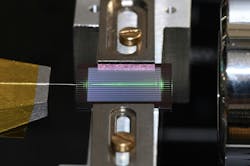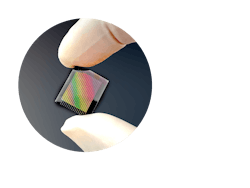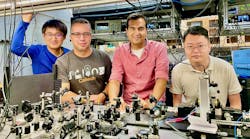Nanophotonic OPO enables broadband coherent light sources
In an advance for frequency combs, Alireza Marandi, a professor of electrical engineering and applied physics at Caltech, and his team recently created a nanophotonic device to produce a broad range of laser light frequencies with ultrahigh efficiency on a microchip.
How did they pull it off? By combining dispersion engineering—shaping the way different wavelengths of light move through a device without spreading out—with a specially designed OPO to efficiently broaden the spectrum and maintain coherence.
Marandi’s team set out to create an integrated wavelength-agnostic frequency-comb source, but knew they’d need a new OPO design. OPOs within bulky tabletop systems are well-known sources to tune the output or get a relatively broad output comb—they’ve been around since the mid-1960s. But beyond being bulky, tabletop OPOs are pump-power hungry and sensitive to alignment. Marandi jokes that tabletop OPOs need two graduate students to operate, and it sums up why OPOs have barely made it out of research labs.
OPOs are similar to lasers because they’re resonators with optical gain. “But unlike lasers, the gain is parametric gain provided by a nonlinear material and a pump,” explains Marandi. “Parametric gain spectrum, unlike laser gain, is not limited to the electronic or molecular transitions and instead can be designed, almost arbitrarily, in the transparency window of the nonlinear material.”
These universal sources are essential for nanophotonic circuits to make wavelength agility accessible for a wide range of applications. “Recently, my group demonstrated how nanophotonic OPOs can be used as ultrabroadly tunable sources—within the continuous-wave and frequency comb regimes,” says Marandi. “In our latest work, we wanted to extend the instantaneous bandwidth of these OPOs as broadband coherent sources.” (See video.)
OPO design/method
The team’s nanophotonic OPO is synchronously pumped within thin-film lithium niobate (TFLN), with a special resonator design.
“First, the round-trip time of the resonator is matched to the repetition rate of the mode-locked laser pump, which is 4 ns (250 MHz) and corresponds to ~0.5 m of length on the chip; it’s packed into a spiral shape,” says Ryoto Sekine, a former student in Marandi’s lab and cofounder of PINC. “The dispersion of the resonator is designed to be close to zero—both in terms of group velocity dispersion (GVD) and the group velocity mismatch (GVM) between the pump and the signal at half of the pump frequency. As a result, we’re operating within an OPO operation regime, which wasn’t accessible before in terms of dispersion and strength of nonlinearity.”
It makes nanophotonic OPOs “superior to tabletop OPOs because the submicron confinement of light within the nanophotonic circuit yields much higher intensities for the same powers,” Sekine says. “And dispersion engineering, which isn’t available in bulk, allows further temporal confinement of energy within shorter pulses. It allowed us to achieve the record-low pump threshold for these OPOs within the femtojoule regime.”
Beyond designing the linear nanophotonic components, such as the dispersion of the waveguides and resonator couplers, the team performed nonlinear simulations to better understand OPO behaviors. “It’s critical for the ultrashort-pulse regime because most of the analytic and reduced models of OPOs are not valid within this regime,” Marandi says.
When Marandi’s team turned the OPO on, cranked up the power, and looked at the spectrum, it was extremely broad. “We were particularly surprised that this super-broad spectrum was actually coherent,” he says. “It went against textbook descriptions of how OPOs work and sent us back to the simulations and to theory to try to figure out how it was possible.”
Their simulations raised the energy of incoming light above the threshold and caused the spectrum to become incoherent (no frequency comb is generated).
Surprisingly, back in the lab, the team found the spectrum was coherent when operating farther above threshold. It took them months to discover this was a new regime of OPO operation—far above its threshold—where coherence is reestablished. They observed “phenomenal spectral broadening that’s orders of magnitude more energy-efficient than other methods,” says Marandi.
One technical challenge was that this nanophotonic OPO is pumped by a commercial mode-locked laser—which is neither cheap nor integrated. “With the ultralow-energy operation, these OPOs can be pumped using the fast-evolving integrated ultrashort-pulse sources such as our own integrated mode-locked laser within the same TFLN platform,” says Sekine.
Applications ahead
What does the team’s work mean for nanophotonics, PICs, sensing, and communications? “The first and most important enabling feature of our OPOs is lifting the spectral limitations of integrated coherent sources,” says Marandi. “Our nanophotonic OPO can enable coherent light sources within PICs—from visible to mid-infrared. Many PIC-based systems are currently limited by the existing laser sources, and our nanophotonic OPO technology can be valuable for atomic and molecular sensing, ranging, and communication.”
Another important but less obvious application of OPOs the team’s pursuing is computing and information processing. “These ultrafast OPOs can serve as the fundamental building blocks of classical and quantum photonic computing architectures, and our current demonstration shows how energy-efficient they can be,” Marandi points out.
Delving into the physics of OPOs
On the research side, “we’re still exploring the rich physics of OPOs,” says Marandi. “It’s interesting that OPOs have been around since 1965, but there are still so many fundamental unknowns about them. The spectral recoherence we discovered and used for our work is one example, but the nanophotonic OPOs are also a fertile ground for studying a wide variety of solitons and also quantum states. We’re exploring OPO-based nanophotonic circuits using these unexplored operation regimes.”
On the commercialization side, Marandi’s lab launched spinoff PINC Technologies to deliver their OPOs and other nonlinear photonic technologies in practical packaged formats to enable their use across diverse photonic products and R&D for next-generation devices.
FURTHER READING
R. Sekine et al., Nat. Photon. (2025); https://doi.org/10.1038/s41566-025-01753-7.
Related Article
About the Author
Sally Cole Johnson
Editor in Chief
Sally Cole Johnson, Laser Focus World’s editor in chief, is a science and technology journalist who specializes in physics and semiconductors.



